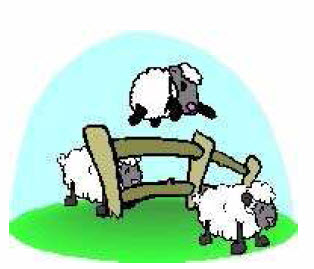hdu 2952 Counting Sheep
Counting Sheep
Time Limit: 2000/1000 MS (Java/Others) Memory Limit: 32768/32768 K (Java/Others)
Total Submission(s): 3524 Accepted Submission(s):
2366
Problem Description
A while ago I had trouble sleeping. I used to lie
awake, staring at the ceiling, for hours and hours. Then one day my grandmother
suggested I tried counting sheep after I'd gone to bed. As always when my
grandmother suggests things, I decided to try it out. The only problem was,
there were no sheep around to be counted when I went to bed.

Creative as I am, that wasn't going to stop me. I sat down and wrote a computer program that made a grid of characters, where # represents a sheep, while . is grass (or whatever you like, just not sheep). To make the counting a little more interesting, I also decided I wanted to count flocks of sheep instead of single sheep. Two sheep are in the same flock if they share a common side (up, down, right or left). Also, if sheep A is in the same flock as sheep B, and sheep B is in the same flock as sheep C, then sheeps A and C are in the same flock.
Now, I've got a new problem. Though counting these sheep actually helps me fall asleep, I find that it is extremely boring. To solve this, I've decided I need another computer program that does the counting for me. Then I'll be able to just start both these programs before I go to bed, and I'll sleep tight until the morning without any disturbances. I need you to write this program for me.

Creative as I am, that wasn't going to stop me. I sat down and wrote a computer program that made a grid of characters, where # represents a sheep, while . is grass (or whatever you like, just not sheep). To make the counting a little more interesting, I also decided I wanted to count flocks of sheep instead of single sheep. Two sheep are in the same flock if they share a common side (up, down, right or left). Also, if sheep A is in the same flock as sheep B, and sheep B is in the same flock as sheep C, then sheeps A and C are in the same flock.
Now, I've got a new problem. Though counting these sheep actually helps me fall asleep, I find that it is extremely boring. To solve this, I've decided I need another computer program that does the counting for me. Then I'll be able to just start both these programs before I go to bed, and I'll sleep tight until the morning without any disturbances. I need you to write this program for me.
Input
The first line of input contains a single number T, the
number of test cases to follow.
Each test case begins with a line containing two numbers, H and W, the height and width of the sheep grid. Then follows H lines, each containing W characters (either # or .), describing that part of the grid.
Each test case begins with a line containing two numbers, H and W, the height and width of the sheep grid. Then follows H lines, each containing W characters (either # or .), describing that part of the grid.
Output
For each test case, output a line containing a single
number, the amount of sheep flock son that grid according to the rules stated in
the problem description.
Notes and Constraints
0 < T <= 100
0 < H,W <= 100
Notes and Constraints
0 < T <= 100
0 < H,W <= 100
Sample Input
2
4 4
#.#.
.#.#
#.##
.#.#
3 5
###.#
..#..
#.###
Sample Output
6
3
#include <iostream> using namespace std; int n,m; char a[105][105]; int d[4][2]={1,0,-1,0,0,1,0,-1}; int s; bool safe (int x,int y) { if(x>n||y>m||x<=0||y<=0) return 0; return 1; } void dfs(int x,int y) { a[x][y]='.'; int i; for(i=0;i<4;i++) { int xx=x+d[i][0]; int yy=y+d[i][1]; if(!safe(xx,yy)) continue; if(a[xx][yy]=='#') { a[xx][yy]='.'; dfs(xx,yy); } } } int main() { int T,i,j; cin>>T; while(T--) { cin>>n>>m; s=0; for(i=1;i<=n;i++) { for(j=1;j<=m;j++) { cin>>a[i][j]; } } for(i=1;i<=n;i++) { for(j=1;j<=m;j++) { if(a[i][j]=='#') { s++; dfs(i,j); } } } cout<<s<<endl; } return 0; }

